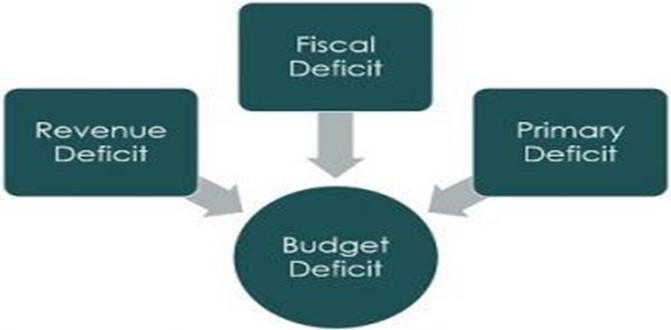The Budgetary deficits are being often discussed in various economic and financial forums. It has impact on Government spending and hence overall wellbeing of the citizens are affected due to these deficits. Let us understand the meaning of commonly used deficit terms.
There are 3 main budgetary deficits:
Fiscal Deficit
Primary Deficit
Revenue Deficit
To understand these common deficits, we must be clear on 2 concepts i.e Revenue receipts/expenditure and Capital receipts/expenditure.
Revenue Receipts/Expenditure:
The receipts and expenditures that are in the nature of day-to-day operations are covered under this.
Capital Receipts/Expenditure:
The receipts and expenditures that are long term in nature and are used for many years are covered under this.
Examples:
| Tax Receipts | Revenue receipts |
| Interest expenditure | Revenue expenditure |
| Debt receipts | Capital receipts |
| Grants for creation of Capital Assets | Capital expenditure |
Fiscal Deficit:
Fiscal deficit can be understood as the difference between total expenditure and total receipt excluding borrowings. In other words, borrowings fill up the gap created by fiscal deficit.
Fiscal deficit = Total expenditure – Total Revenue (excluding borrowings)
Primary Deficit:
If we deduct the interest payments from the fiscal deficit, it gives Primary Deficit.
Primary Deficit = Fiscal Deficit – Interest payments
Revenue Deficit:
The shortfall of Revenue receipts to Revenue expenditure is referred as Revenue Deficit or difference between revenue expenditure and revenue receipt.
Revenue Deficit = Total Revenue expenditure – Total Revenue receipts
All these 3 types of deficits reflect the health of the financial system of the country.
Please see Budget at a glance of Union of India to understand these deficits more precisely.
| बजट का सार Budget at a Glance | ||||||
| (In ₹ crore) | ||||||
| 2023-2024वास्तववक Actuals | 2024-2025बजट अनुमान BudgetEstimates | 2024-2025संशोधित अनुमान RevisedEstimates | 2025-2026बजट अनुमान BudgetEstimates | |||
| 1. राजस्व प्राप्तियां | 1. Revenue Receipts | 2729036 | 3129200 | 3087960 | 3420409 | |
| 2. कर राजस्व(केंद्र को प्तनवल) | 2. Tax Revenue (Net to Centre) 1 | 2327251 | 2583499 | 2556960 | 2837409 | |
| 3. कर भिन्न राजस्व | 3. Non-Tax Revenue | 401785 | 545701 | 531000 | 583000 | |
| 4. पं जी प्राप्तियां | 4. Capital Receipts | 1714411 | 1691312 | 1628527 | 1644936 | |
| 5. ऋणों की वस ली | 5. Recovery of Loans | 26646 | 28000 | 26000 | 29000 | |
| 6. अन्य प्राप्तियां | 6. Other Receipts | 33122 | 50000 | 33000 | 47000 | |
| 7. उिार और अन्य देयताएं | 7. Borrowings and Other Liabilities 2 | 1654643 | 1613312 | 1569527 | 1568936 | |
| 8. कुल प्राप्तियां (1+4) | 8. Total Receipts (1+4) | 4443447 | 4820512 | 4716487 | 5065345 | |
| 9. कुल व्यय (10+13) | 9. Total Expenditure(10+13) | 4443447 | 4820512 | 4716487 | 5065345 | |
| 10. राजस्व खातेपर | 10. On Revenue Account | 3494252 | 3709401 | 3698058 | 3944255 | |
| जजसमें से | of which | |||||
| 11. ब्याज िुगतान | 11. Interest Payments | 1063872 | 1162940 | 1137940 | 1276338 | |
| 12. पं जी खाते के सृजन हेतु सहायता अनुदान | 12. Grants in Aid for creation of CapitalAssets | 303916 | 390778 | 299891 | 427192 | |
| 13. पं जी खाते पर | 13. On Capital Account | 949195 | 1111111 | 1018429 | 1121090 | |
| 14. प्रिावी पं जी व्यय (12+13) | 14. Effective CapitalExpenditure (12+13) | 1253111 | 1501889 | 1318320 | 1548282 | |
| 15. राजस्व घाटा (10-1) | 15. Revenue Deficit | 765216 | 580201 | 610098 | 523846 | |
| (10-1) | (2.6) | (1.8) | (1.9) | (1.5) | ||
| 16. प्रिावी राजस्व घाटा(15-12) | 16. Effective RevenueDeficit (15-12) | 461300(1.6) | 189423(0.6) | 310207(1.0) | 96654(0.3) | |
| 17. राजकोषीय घाटा[9-(1+5+6)] | 17. Fiscal Deficit[9-(1+5+6)] | 1654643(5.6) | 1613312(4.9) | 1569527(4.8) | 1568936(4.4) | |
| 18. प्राथभमक घाटा (17-11) | 18. Primary Deficit | 590771 | 450372 | 431587 | 292598 | |
| (17-11) | (2.0) | (1.4) | (1.3) | (0.8) | ||
Source: https://www.indiabudget.gov.in/
Discover more from At Silly Point
Subscribe to get the latest posts sent to your email.

